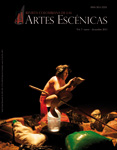Authors
Abstract
Post-dramatic theater is presented nowadays as an interesting possibility to deal with the scenic occurence. However the emergence of this type of theater form has taken to the reflection and the questioning about its dangerousness before the dramatic issue. This is why it is necessary to determine if it is a theater act indeed or if we are, instead facing an invasion of other arts and matters unconnected to the theater essence from its classic conception: drama as a support of the scenic action. Then, who determines its boundaries, its frontiers? More than trying to make a theoretical discourse in this article, I would like to present my own experience on post-dramatic theater, an experience made with work and the staging of: Is This Medea? Grotesque in Red and White.
Keywords
References
Kantor, T. (1984). El teatro de la muerte. Buenos Aires: Ediciones de la Flor.
Miklaszewski, K. (2001). Encuentros con Tadeusz Kantor. México: CONACULTA.
Lehmann, Hans-Thies (2001). “El teatro postdramático”. Consultado en: http://www.leergratis.com/otros/el-teatro-posdramatico.html.
Picó, Josep (1998). Modernidad y postmodernidad.Madrid: Alianza Editorial S.A.
Szondi, Peter (1994). Teoría del drama moderno.Barcelona: Ediciones Destino.

 PDF (Español)
PDF (Español)
 FLIP
FLIP









